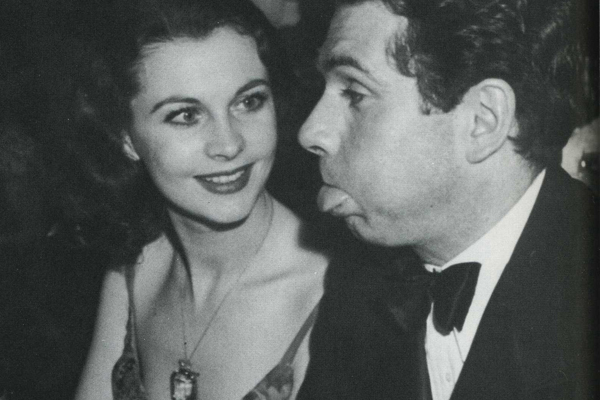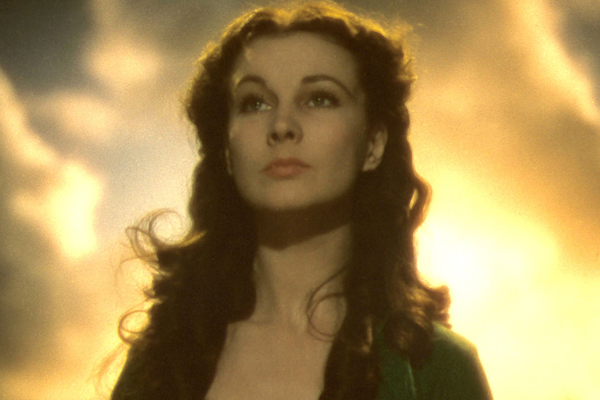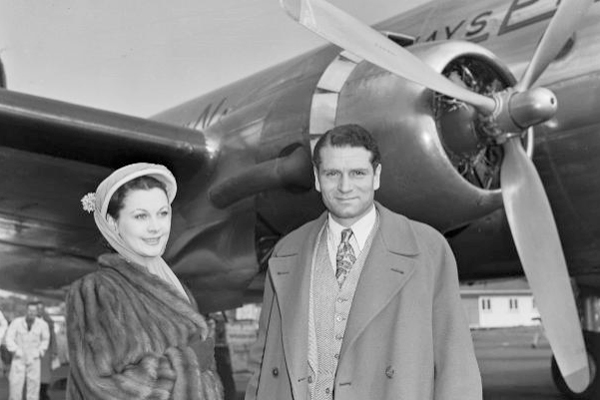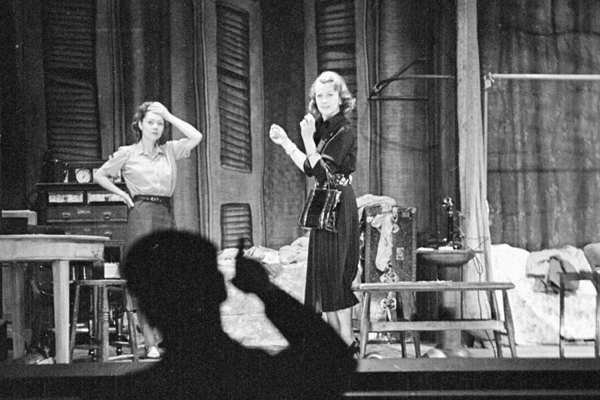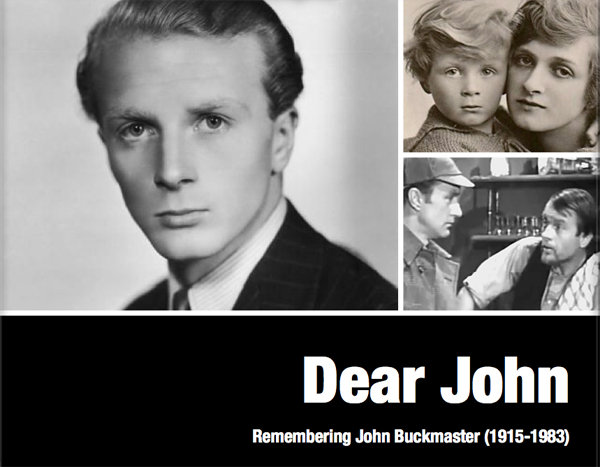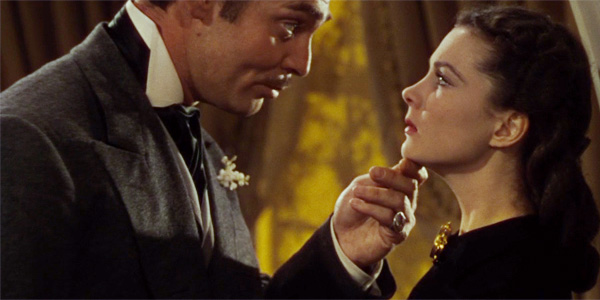Any hard-core history geek knows the thrill of visiting places where one’s favorite historical figures lived, worked, or otherwise stayed. Perhaps even more thrilling is getting a first-hand look at objects and manuscript materials related to said historical figures. This is certainly the case for many Vivien Leigh fans. Long-time friend of vivandlarry.com, Shiroma Nathan, is a Vivien Leigh fan in Australia who recently took the opportunity to go where very few fans have gone before: The National Library of Australia in Canberra. Read about her trip and experience viewing a very special photograph album in this guest blog post.
Category: guest post
guest post london the oliviers
Inside the Oliviers’ Love Nest
Today’s post comes to us courtesy of Lena Backström, a long-time fan of the Oliviers from Sweden. Over the years I’ve gotten to know Lena fairly well. When this site first launched she kindly contributed scans from her private collection to the Photo Gallery – many of which I had never seen before. It was a real treat. Since then, we’ve met in person a couple of times, catching up over lunch and swapping stories whenever she’s in London for a visit.
Recently, Lena did some extended research into Durham Cottage, the Oliviers’ love nest in Christchurch Street, Chelsea, west London. Laurence Olivier bought the house (the former coach cottage belonging to the larger Durham House next door) as a London base for he and Vivien Leigh. Using quotes from biographies and excerpts and rare photos from vintage Swedish magazines, Lena was able to plot out what the house looked like when the Oliviers lived there from 1937-1956.
Below is Durham Cottage as we’ve never seen it, but there are some lingering questions: where, exactly, was Laurence Olivier’s study? When did they decide to have separate bedrooms (or were there always two)? Can you help us with the answers?










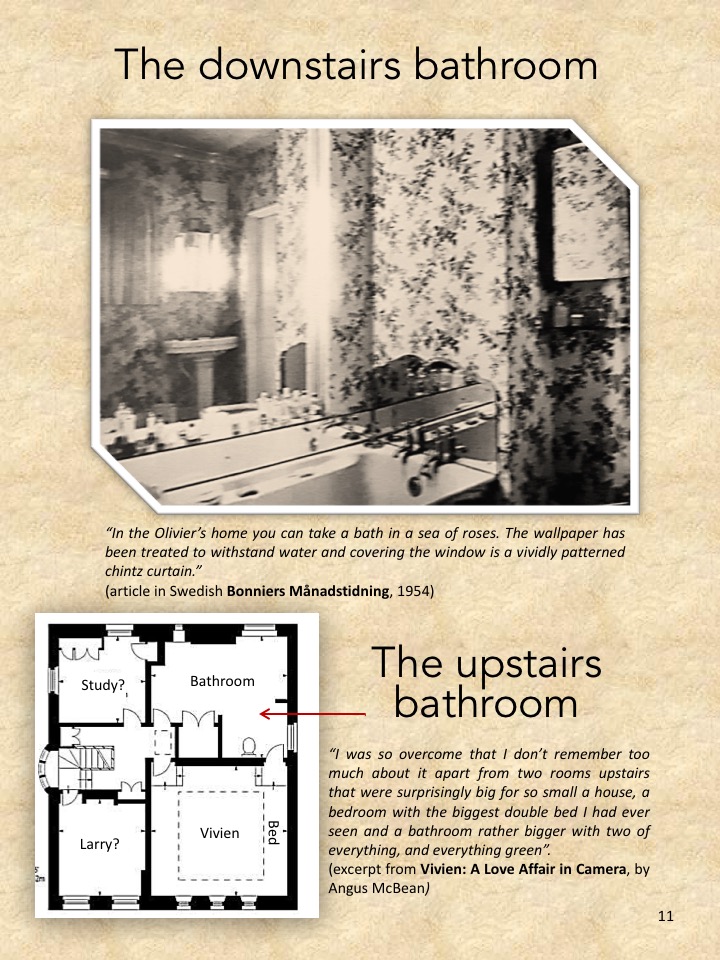




Thanks for the job well done, Lena!
If you’ve got a unique idea for a guest post and would like to contribute to the content at vivandlarry.com, please get in touch.
featured guest post the oliviers
Loving Vivien Leigh and Laurence Olivier – A Fan’s Perspective
Today’s post is brought to you by my friend Irina N., a long-time fan of the Oliviers and at one time administrated a fan site called Vivien Leigh: A Lass Unparalleled – sadly no longer online :(. Here she talks about what continues to drive her interest in Vivien and Laurence Olivier.
*****
As with many other fans, my interest in Vivien Leigh and Laurence Olivier started when I first saw Gone With The Wind. I was 12 and had read the book first and was spellbound by the story and the character of Scarlett. I could not wait to see the movie, but I was also hesitant for fear of being disappointed. One night, my mom who had seen and already loved the movie rented the VHS. We started in the evening and watched it all the way through and well into the night! I was certainly not disappointed. No performance, before or since, has made such a huge impression on me as that of Vivien Leigh as Scarlett O’Hara. Of course, I also thought she was the most beautiful actress ever. I really think that had it not been for her performance, GWTW would not have become the phenomenon that it did. I didn’t find either Clark Gable or Leslie Howard or Olivia de Havilland particularly good matches for the descriptions I remembered from the book (even though I really like these actors in other movies). I pictured Rhett a little differently and Ashley, of course, handsomer and younger. Olivia de Havilland seemed too pretty and lively for Melanie.
But all of these reservations were completely swept away by the force and authenticity of Vivien Leigh’s Scarlett. She makes the movie. She is the one responsible for its enduring success and the classic it’s become. A young British newcomer, whose talent has carried the most celebrated movie though decades, whose performance in one of the most beloved and coveted roles stands the test of time without ever looking dated or unbelievable for even a second. That’s the definition of a classic performance and that’s what Vivien Leigh’s work is: classic. Her Scarlett alone is an achievement that diminishes heaps of performances by other actors. But it was just an early, albeit huge success in Vivien Leigh’s incredible career of quality rather than quantity.
Being primarily a British stage actress and having made only 19 films, eight of them after GWTW, Vivien nevertheless won two Oscars and secured a place among the very few true Hollywood legends. That is a pretty impressive success rate. Her Scarlett and Blanche DuBois are often called the greatest performances by any actress ever captured on film. There’s a phrase – “to capture one’s imagination.” This is what Vivien Leigh did to me, first through her work and then through her incredible life, which I learned about as my interest in this great actress developed.
To learn about Vivien is to be transported into London’s theatre life of the 1930s through 1960s and to be widely exposed to the history of theatre and its participants. Of course, one of the major players in British theatre as well as in Vivien Leigh’s personal life was Laurence Olivier. I find it fascinating to read about their professional partnership and especially about their genuine dedication to theatre. Their personal love story is a separate subject all on its own, in my opinion having more in common with great fictional romances like those in GWTW and Wuthering Heights than with any real-life relationship that I personally ever heard of.
Perhaps it is inevitable that all too often, Vivien Leigh’s life and achievements are framed in terms of her marriage to Laurence Olivier. There’s no doubt he was a major influence on her growth as an actress. But I’m convinced she would’ve achieved the same great success if he had no part in her life. In her early films, which had nothing to do with Olivier she gives very lively and convincing performances. She played Scarlett when she was only 25 and all credit for that is certainly hers alone. Laurence Olivier himself considered her to be very talented and got very upset when critics couldn’t get past her beauty. Alas, the British stage was often an uphill battle for Vivien Leigh, where she fought against the critics’ prejudices that she was better suited to be a beautiful Hollywood movie star than a serious English actress. I for one prefer to judge her on her merit and not on her looks. And her accomplishments on the stage were stellar if you choose to trust the words of people like Laurence Olivier, John Gielgud, Richard Burton or Orson Welles. Many have said that her Lady Macbeth and Cleopatra were among the finest they’ve ever seen. We are fortunate to have a glimpse of her Sabina, and thus can gauge two of her stage performances – Sabina and Blanche albeit captured in later productions. They’re but a small example of the versatility she displayed throughout her career as she played Shaw, Wilder, Williams, Shakespeare and finally Chekhov.
At the end of her life, despite devastating personal setbacks, frail health and an age when most actresses’ careers do indeed decline, she found enough personal strength and professional expertise to lead Old Vic tours all over the world, act in films and win a Tony in a musical. Surely, beauty alone could not have sustained such a consistent, quality-driven career, made all the more extraordinary by her circumstances. This is what amazes me about Vivien Leigh and why I have such great respect for her – this ability to get up and go about her life and work, with the same unwavering commitment to being an actress, nothing less and nothing more. She never rested on her laurels or took short cuts. It would’ve been very easy for her to settle for a comfy life as a Hollywood superstar. She instead chose to come back to war-time England and get back to her first love, which was the theatre. I believe that decision was hers just as much as it was Olivier’s.
What I think she may have perhaps taken from Olivier, is being a grounded and practical professional. It is revealing to read Olivier’s letter to Tennessee Williams in Terry Coleman’s book, where he sounds more like a detail-oriented engineer than an “inspired artist”. His approach was sensible and crafty, always centering on the audience, not some vague “self-expression”. To me, this just shows how well he knew what he was doing. I saw the Three Sisters recently, which he directed after his National Theatre production, and the whole flow of the movie and of course the acting of the ensemble are outstanding, just as you’d expect from a British theatre company. It is people like Laurence Olivier, with their technique and no-nonsense approach that helped to uphold and secure the reputation of the British theatre.
Given my high regard for both Vivien Leigh and Laurence Olivier, I find it both sad and puzzling that these two great actors are largely remembered only by their dedicated fans, rather than by the public at large, unlike, say, Marilyn Monroe or Audrey Hepburn. It might’ve been somewhat understandable had Vivien Leigh been just a well-regarded stage actress. But she was a movie star and a great beauty, one of only a handful of truly naturally beautiful actresses. I’m sure part of it has to do with simple publicity and media exposure, but I think there is also the fact that Vivien Leigh herself was always after being a serious stage actress, rather than a movie star. She steered her career and her lifestyle towards that aim, never having much interest in fame and publicity. When people recognize the name Vivien Leigh, they think of her roles rather than some image derived from her personal life. Vivien’s personality disappears behind her professional achievements, and it is up to the fans to find out more about her. She’s not an icon or a persona or a symbol. She’s just an actress.
When we think of Audrey Hepburn, we think of her own personal style. When we think of Vivien Leigh, we think of Scarlett and Blanche and for those who are aware of her theatrical triumphs – her Cleopatra, Lady Macbeth, Paola, Sabina, etc. Similarly, Laurence Olivier, having been a handsome romantic Hollywood leading man, easily went between that and Shakespeare, modern and classic plays, leading and supporting roles. There’s no persona of Laurence Olivier, but there are Hamlet, Richard, Heathcliff, Hurstwood, etc. These were real and private people who simply concentrated on doing their job well. I personally find this dedication to their profession worthy of great respect and admiration and I actually cannot think of any other famous stars who always remained primarily committed to their original choice of being an actor, rather than someone famous. It is unfortunate that people of lesser talent and accomplishment are the ones that are remembered today, just because neither Vivien Leigh nor Laurence Olivier ever cared about being legends, but simply went about their work.
*****
Irina has been a fan of Vivien Leigh’s for over 20 years. She maintained a comprehensive website about VL called a “Lass Unparallel’d” in the early 2000s. This website contained one of the largest online collections of VL photos at the time, which Irina mostly scanned from different books and some other printed materials. She had to take somewhat of a break from her hobby, but is very happy to return to it now and to the vibrant community of fans that have gathered around Kendra’s FB page and vivandlarry.com.
friends of the oliviers guest post
Dear John: Remembering John Buckmaster
Dear John: Remembering John Buckmaster
by Tanguy
John Buckmaster. The name sounds familiar to all those interested in Vivien Leigh. Wasn’t he the man making fun of Larry and his new mustache that first day at the Savoy Grill, when it is said that all really began? John Buckmaster. A name. A silhouette. Yes, now you see him better. But didn’t he turn totally mad in the end? Wasn’t he the one…? Yes, now you know. THAT John Buckmaster.
No matter how many biographies of Vivien Leigh you may have read, that’s all there is to it. John Buckmaster, stuck forever in that dramatic chapter. And when that one is closed, there goes John Buckmaster, back to obscurity.
And yet…
Posing in front of the camera in 1934, in a beautiful striped suit, exquisitely tailored, John Buckmaster was a vision of absolute elegance and beauty. He had the dreamy blue eyes of his mother – once the most photographed girl in London – and the manly bone structure of his father, with the spiritual nose and attractive mouth.
He was born on July 1915 to Gladys Constance Cooper – beloved actress and glorious beauty – and Herbert John Buckmaster, survivor of the Boer War; a great gambler and womanizer; a total black sheep; but a darling who kept in touch with his wife even after their divorce, giving lunch whenever she was in touch, arranging parties to celebrate her first nights, behaving less like an ex-husband and more like an intensely proud elder brother.
John must have loved that man who always behaved like a child himself, not hesitating to ride down from London to Charlwood on a pony to visit his children. There in a big Manor House in Surrey, John grew up in an enchanted world, sharing his life with several sheep, wallabies, a snake, a pet monkey, and a sister called Joan.
Several people with funny names came to visit. Mostly men, specially after his father left for the war. Ivor Novello, Raymond Massey, The Duke of Westminster. One day, Gerald du Maurier came by to have a glance at the menagerie. He was bitten by the monkey.
Beauty was everywhere — had to be everywhere. John’s mother had an issue with ugliness, illness, exhaustion and inefficiency. She couldn’t tolerate them and considered being less-than-perfect a mark of weakness to be fixed properly.
Accordingly, John developed the most elegant manners, the most delicate smile, and even took some boxing lessons with a friend of his father to improve his body and balance. One summer, when he was 9, he created a display and a cartoon was published in the Evening Standard. Both his father and mother got in touch with the cartoonist the following morning to buy the original drawing. In deep confusion, the artist wrote to Buck who replied, “It’s perfectly simple, dear fellow: I shall purchase it and you shall send it to Miss Cooper’s dressing room”. A kind of goodbye gift as the divorce became official in 1921.
It was not long before new items were added to the family menagerie. In 1928, John’s mother married Sir Neville Pearson, a handsome and titled baronet ten years younger than his bride. He was heir to a publishing firm and had just ended a disastrous marriage himself. John heard of their brief honeymoon in the south of France. Now studying at Eton, he must have felt a jealous sting as his mother seemed to have no trouble in taking on Pearson’s various stepchildren as her own. She seemed to take rather more interest in her new baby, Sally. She led a less mundane and active life than she had managed at the time of John’s birth, when the demands of her career were more exclusive.
Far from the imperious eye of his mother and not knowing about the cracks in the perfect mirror of her new, happy life, John faced adolescence alone. Sensitive, highly strung, extremely handsome and wittily talented, he couldn’t help but resent the man who had interfered with his close relation with his mother. He had taken an intense dislike to Pearson and it was reciprocal.
Had he known that after some sensual years the Pearson’s marriage was to turn to ruin, maybe John would have reconsidered his views. Later in life he would blame his eventual collapse on his mother’s inability to cope with him.
Out from Eton, with his looks, his talent, and his connections, he decided to start an acting career of his own. He played with Cedric Hardwicke, in Tovarich, settled in a little flat of his own in Chelsea, and started dating young and beautiful women, like Jean Gillie, and a certain Vivien Leigh.
According to Hugo Vickers, Vivien told Jack Merivale that John had been the first man she had an affair with after her marriage to Leigh Holman. In August 1935 they had spent a week end in Kent together. They shared youth and the love of fun and excitement. In short, they were made one for each other. According to his stepsister, Sally, Vivien was the love of his life. What would John’s life have been, had a certain Laurence Olivier not arrived on the scene?
Larry, was not a total stranger to John. In 1933, Gladys Cooper had secured the young unknown actor to play in “The Rats of Norway”. With her keen eye on youth, beauty and talent, she must have felt a certain attraction to young Larry, and according to him, showed nothing but kindness and generosity. So Vivien couldn’t have dreamed of a better escort to introduce them at the Savoy Grill, where Olivier and his wife, Jill Esmond, used to dine at the time he was playing “Romeo and Juliet.” The rest is history.
It must have been a cruel experience to see the woman of his dreams totally mesmerized by somebody else. But John had learned to hide his feelings and put on a happy face. On April 30th, 1937, Gladys Cooper, John’s mother, got married for the third time. The new stepfather’s name was Philip Merivale, a 47 year old English actor and widow of Viva Birkett, by whom he’d had four children. This time, John decided to smile. Not only did he put up with his new family – among which was a stepbrother named Jack Merivale – but when his mother decided to tour America with her new husband, he decided to come along. In 1938, he played on Broadway in a Dodie Smith family comedy, “Call it A Day”. Handsome and already accomplished as an actor, he seemed destined for a brilliant future. He decided to forget the Pearson episode, got on well with his mother, and also took kindly to Philip Merivale who wanted nothing more than the fusion of the two families. After “Call it A Day”, and flattering appearances in all the best gossip columns of New-York, he accepted the part of Lord Alfred Douglas opposite Robert Morley’s Oscar Wilde. Off stage, he seemed to have found in America a place to suit his ambition and sense of adventure. He started writing songs and made quite a name for himself in cabaret. But life decided to play another trick. War broke out in September 1939 when he was just 24.
“Phil says John is doing very well in cabaret at the Algonquin and though people keep writing to me from England saying that he should go back and fight with the others, I really haven’t the heart to persuade him to give up his New-York life…” So wrote Gladys Cooper just after seeing Laurence Olivier and Vivien Leigh back to England in 1940. Although nothing is certain about his state of mind at that stage, one can assume that the pressure on John was intense. He felt split between his mother’s will to keep him close and safe, his own guilt at letting his friends go, and leading a secure life. In July 1941, Gladys wrote again: “John has decided to go home and fight; though it frightens me I think this is probably for the best”. John’s stepbrother Jack Merivale had married a young actress called Jan Sterling had decided himself to enlist in Canada. The Farewell Party took place in Central City, Colorado where John was appearing in a very successful show of his own. His mother was surprised to be presented for the first time as “John Buckmaster’s mother”.
It would be four years until John went back to California. He was on leave and met his stepbrother there. It was the first time Jack Merivale noticed the inner tensions of his relative and the distinct uneasiness in John’s relation with his mother. “I shall never forget her coming back that time from England and looking at us all in the house and saying, ‘You must all have had a lovely time – everyone does while Mum’s away’ – and then another morning John and I were standing in the drive watching her drive off somewhere and suddenly John breathed a great sigh of relief and said, ‘Whenever I’m with her, I feel I’m always doing the wrong thing, whatever it is’. That was her own son, whom she adored: she was curiously unable, I think, to make even those she most loved feel that love very often.”
When Philip Merivale died of a heart ailment in March 1946, Gladys reacted as she always had, by turning her mind on something else. She threw herself back into work and decided to do it in a revival of Lady Windermere’s Fan with a cast including her own daughter, Sally, John and Jack. They opened in California and then travelled to Broadway where they played the 1946-47 season. At the end of that run, Jack and Sally returned to Gladys in California, leaving John to stay with friends in New-York. It was then, via a phone call, that Gladys learnt her son had suffered the first of many mental breakdowns which were to become a regular and increasingly violent part of their lives for the next ten years.
“There is neither the place nor the expertise here for an analysis of that condition”, wrote Sheridan Morley in his 1979 biography of his grandmother, Gladys Cooper. “Briefly: the strains of a war in which he’d felt himself perhaps involved too distantly and too late, of a number of increasingly unhappy love affairs, and of maintaining a career which had began with rather too much glitter and not enough training, were proving too much for John, and under those pressures and the other pressure of being Glady’s son he was now, slowly but surely, to crack – temporarily at first, then for longer periods…”
What is sure, is that his mother could never bring herself to fully accept that her only son was mentally unstable. Invariably, she would refer to his condition as “flu”, even when shock treatment were necessary to contain his acutely schizophrenic condition. Mental illness – however sad it is – was for her a sign of weakness, something to be ignored and overcome rather than treated.
John Buckmaster, from then on, was on a series of highs and downs. The smiling boy with the golden curls turned into a haunted spirit, more and more dependent on drugs and treatments and trying hard to keep up with the gentle and perfect silhouette his mother wanted him to be. At her Pacific Palisade home in 1947, he is a short sleeved young man, sitting by a little table under the porch facing the swimming pool. Five years later, in New York, he will be chased by the police to Park Avenue and 75th Street, accused of molesting women, and arrested in possession of two kitchen-type knives. Sent to Bellevue Hospital for psychiatric observation, he was admitted one month later to the state hospital at Kings Park, Long Island. Jack Merivale and Noël Coward took action to have him sent back to England on the condition that he went into treatment there and never return to the New York state again.
It was but one year later that he reappeared in Hollywood in one of the most dramatically written episode in all the Vivien Leigh biographies.
Little is know of the relationship John Buckmaster managed to keep with Vivien after she met Laurence Olivier. Larry must have resented the vicinity of Vivien’s old flame. But one can’t imagine Vivien – even for the sake of her love – giving up such a funny and handsome partner. She had always been faithful to the people who had been close to her and one doesn’t see why it would have been different with John. Besides, she had always been a great admirer of John’s mother. Gladys Cooper, in her eyes, remained the greatest beauty of her time. And when she came to California to film Gone With the Wind she made sure to keep in touch with John’s mother, now an eminent part of the group of British exiles in Hollywood. They must have met on Sundays when there was cricket on the lawn followed by a tea party. One corgi had some lovely puppies and Gladys decided to call one Scarlett, “because she looks just like Vivien and is very tempestuous”.
Larry and Vivien had also been acquainted with Jack Merivale, who had joined the cast of “Romeo and Juliet” to play the bit part of Balthasar. John must have heard about the news with mixed feelings. The more he tried to get away from Vivien, who was now happily married to Larry (“at last” his mother had written), the closer she seemed to get with the rest of his family. Missing the opportunity to act with Larry and Gladys in “Rebecca”, Vivien got her revenge in Korda’s Lady Hamilton, where John’s mother played the stern figure of Lady Nelson.
So, despite the years passing by, the link between Vivien and John had never been broken. After all, they had been young together, and shared the same expectations of a glorious future and perfect tomorrows, until war and reality cast their black shadows. The set of A Streetcar Named Desire, where John visited one day in Hollywood, was the proper place for a reunion. One can imagine their mutual state of mind, both by now having a history of mental illness. Once they had been partners in fun and laughter. Now they started mentally to drift away, nourishing their inner monsters with the cruel knowledge that no one really understood them. In these doomed circumstances, Vivien would be luckier in a sense. She had a husband, friends, family who fought for her and who tried desperately to build a wall between her illness and the world. John had nothing of the sort to protect him against the morbid curiosity of the press. His name was splashed across the pages of magazines, no longer in the elegant gossip columns but under the most frightening titles: “Felonious assault”, “Concealed weapons”, “Sent to State Hospital”. Then Vivien’s nightmarish breakdown happened in 1953, leaving readers with the image of John Buckmaster as a tragic and grotesque figure; soon to be removed from the set dressed in a towel, tearing up money, and asking Vivien to fly out of an upper window with him.
The little boy with the shy smile who had posed in so many happy photographs in town, in the country, even at the beach, seemed to have torn apart the family album. He bravely attempted to revive his acting career in the years to come, appearing briefly in some episodes of Sherlock Holmes for television; playing bartenders and butlers; a thin figure, still handsome, with a funny accent. He refused to see either of his parents, both of whom he blamed for his breakdowns, before settling into the clinic where he would live out the latter half of his life. Did he hear about Vivien’s fate? Larry made sure, after the 1953 episode, that they never got in touch again. John must have heard of the divorce, and of Jack living with Vivien. Such irony. And then, little by little, they were gone. Vivien first, in 1967. Then his mother, in 1971, from lung cancer. Approaching 70 she had started learning to type but had left when the instructors objected to the length of her fingernails. What couldn’t she do besides making her son happy and healthy? The world which had been such a funny place then turned to a big black shadow, place which no longer interested little Johnny. It was there, in the Priory, that he committed suicide on April 1, 1983.
He was 68.
cinema experiences gone with the wind guest post
{Guest Post} Gone with the Wind at the Egyptian Theatre
I always love reading about other people’s cinematic classic film viewing experiences. Some films were simply meant to be seen in the cinema, as is the case with Gone with the Wind. Last weekend, GWTW was screened at the magnificent Egyptian Theatre on Hollywood Boulevard. This venue, home to the American Cinematheque, is a haven for film nerds in the movie capital and has a special place in my heart. So, when I learned a couple of my friends were meeting up and going to the screening, I immediately invited one of them to write about her experience for vivandlarry.com. Luckily she said yes!
Marissa recently relocated from New York to Los Angeles where she is currently enrolled in the Archival Studies graduate program at UCLA. This past May, she attended A Weekend with the Oliviers, the event put on through vivandlarry.com in London. Over in LA, as someone who has always loved film and film history, Marissa is enjoying all the city has to offer.
++++
No other film has made more of an impact on my life or means as much to me as Gone with the Wind, and just as I’ll never forget watching it for the very first time when I was eleven, I’ll never forget the experience of seeing it for the first time on the big screen. This is something that I had hoped to do for a long time and was able to experience last Saturday.
I had the great fortune to see Gone with the Wind at the beautiful and historic Egyptian Theatre. The grandeur of the theatre is a sight to behold in itself. Kendra, a very thoughtful friend, put me in contact with her friend Mark and I was able to share the experience with him and his friends, which made the viewing all the more enjoyable.
Before the film was shown, the programmer said that our socks would be knocked off and he was right. Viewing the digital print and hearing Max Steiner’s score at the Egyptian Theatre added even greater depth to the movie. Being part of a large audience was truly a unique experience that enhanced and heightened moments of humor and tension.
There are so many exceptional elements that come together seamlessly to make Gone with the Wind so very special, but above all it’s the brilliant performances by Vivien Leigh, Clark Gable and the rest of the cast that always mesmerize me. The experience of seeing it on the big screen was even better than I imagined and, as always, when watching it, I didn’t want it to end.
++++
If you’ve had a chance to see a Vivien Leigh or Laurence Olivier film on the big screen and want to share your experience with other fans, feel free to get in touch.
Check out more Cinema Experiences here.



